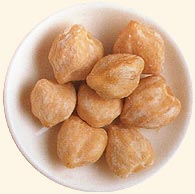Tags
asian, Asian Ingredients, candlenut, cooking, Herbs & Spices, indisch eten, indisch koken, indonesia food, ingredients, kemiri
 Kingdom: Plantae
Kingdom: Plantae
Division: Magnoliophyta
Class: Magnoliopsida
Order: Malpighiales
Family: Euphorbiaceae
Subfamily: Crotonoideae
Tribe: Aleuritideae
Subtribe: Aleuritinae
Genus: Aleurites
Species: A. moluccanus
Binomial name: Aleurites moluccanus
The nut is often used cooked in Indonesian and Malaysian cuisine, where it is called kemiri in Indonesian or buah keras in Malay. On the island of Java in Indonesia, it is used to make a thick sauce that is eaten with vegetables and rice. Outside of Southeast Asia, macadamia nuts are sometimes substituted for candlenuts when they are not available, as they have a similarly high oil content and texture when pounded. The flavor, however, is quite different, as the candlenut is much more bitter. It is mildly toxic when raw.
Several parts of the plant have been used in traditional medicine in most of the areas where it is native. The oil is an irritant and laxative and sometimes used like castor oil. It is also used as a hair stimulant or additive to hair treatment systems. The seed kernels have a laxative effect. In Japan its bark has been used on tumors. In Sumatra, pounded seeds, burned with charcoal, are applied around the navel for costiveness. In Malaya, the pulped kernels or boiled leaves are used in poultices for headache, fevers, ulcers, swollen joints, and gonorrhea. In Java, the bark is used for bloody diarrhea or dysentery.